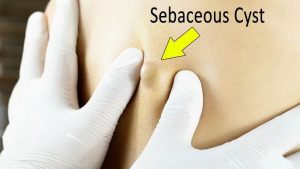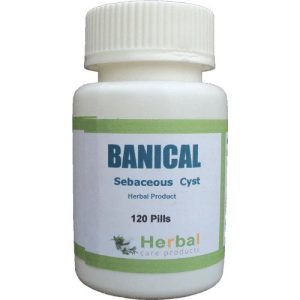No products in the cart.
Return To Shop 0 Cart $0.00 0
No products in the cart.
Return To Shop Shopping cart (0)
Subtotal: $0.00
Free shipping over 299$
A Comprehensive Guide to Natural Remedies for Sebaceous Cysts
Are you dealing with sebaceous cysts and looking for a natural solution? If so, you’ve come to the right place. We’ll provide you with a comprehensive guide to natural remedies for sebaceous cysts. From lifestyle changes to home remedies, we’ll cover it all and help you find the relief you need. Keep reading to learn more!
What are Sebaceous Cysts?
A Sebaceous Cyst is a non-cancerous lump typically found on the face, neck, or torso. It is filled with a white, oily substance called sebum that is naturally produced by the sebaceous glands in our skin. This type of cyst can generally be left untreated unless they become infected or inflamed, however it is still best to consult a doctor should you find any lumps or bumps on your body.
A Sebaceous Cyst is a harmless lump under the skin that can form anywhere on the body, but which is typically found on the face and scalp. They are most often caused by blocked sebaceous glands, which secrete an oily substance called sebum to lubricate your skin and hair. A Sebaceous Cyst can become tender, red and swollen if it becomes infected. While they are not generally dangerous or painful, you should always have it looked at by a doctor if you notice one forming.
Finally, while a Sebaceous Cyst is benign, if it causes pain or becomes infected then medical advice should be sought. Ignoring the cyst in this case can worsen the condition and may require treatment. Therefore, it is important to monitor any Sebaceous Cysts closely to ensure that they do not become painful or infect

Causes of Sebaceous Cysts
Sebaceous Cysts are typically caused by blocked sebaceous glands, which naturally produce an oily substance known as sebum. This can become trapped and lead to a cyst developing. Treatments for sebaceous cysts usually involve draining the cyst itself or removing it surgically. In some cases, natural treatments such as warm compresses or tea tree oil may help reduce the size of the cyst and prevent further growth.
Sebaceous cysts are typically the result of a blockage in the sebaceous gland. However, injury or trauma to the affected area can also lead to their development. In such cases, an infection can occur resulting in inflammation and cyst formation beneath the skin. If disrupted, sebaceous cysts can become painful and require medical attention as they may become infected and filled with pus.
Again, it is important to note that certain skin conditions, such as acne or dermatitis, can also increase the risk of developing a sebaceous cyst. It is therefore important to monitor your skin and visit your doctor if any unusual changes are noticed. Taking preventive measures and proper precaution can help prevent the formation of sebaceous cysts.
Symptoms of Sebaceous Cysts
A Sebaceous Cyst is a common, painless lump that can often appear near the hair follicles on your scalp or face. It may be filled with pus, feel tender when touched, and appear to be more prominent when you are experiencing stress. In some cases, these cysts will go away on their own without treatment. However, it is important to speak with a medical professional if you have any concerns regarding a Sebaceous Cyst.
Sebaceous cysts are naturally occurring bumps that can form either near the surface of the skin or deeper underneath it. Generally, these cysts are harmless and cause no discomfort, however, if a sebaceous cyst becomes infected then you may experience redness, swelling and tenderness in the area. If this occurs, you should seek medical advice immediately.
Meanwhile, naturally it is best to look after your skin and keep an eye out for any changes that you may observe. If you experience any pain or discomfort from a sebaceous cyst, it is important to seek medical advice from a professional for diagnosis and treatment. This will should help ensure the safe and effective management of the cyst.
Treatments for Sebaceous Cysts
Sebaceous cysts are a common skin condition that can be effectively treated by surgical removal. This procedure is the most effective method of dealing with the cyst and will help to relieve any discomfort or inflammation it may have caused. During the procedure, the cyst will be surgically opened and all of its contents will be removed in order to eradicate any recurrence risk. Recovery time after this surgery generally takes a few days and won’t require any long-term hospital stay. The results should be instant, with no lasting side-effects of having had a sebaceous cyst.
A sebaceous cyst occurs when a hair follicle or skin pore becomes blocked, resulting in a buildup of oil beneath the skin. In some cases, a doctor may also prescribe antibiotics to help reduce the swelling and inflammation of the cyst. Alternatively, there are some natural treatments that can be used to reduce the size or severity of a sebaceous cyst; these methods include warm compresses and topical ointments for mild cases.
All in all, a sebaceous cyst is a naturally occurring condition that can generally be managed without medical treatment. Therefore, it is important to take proactive steps to keep the affected area clean and dry, which can help prevent secondary bacterial infections from occurring. Depending on the severity of the cyst, it may be necessary to apply topical antibiotics or creams in order to maintain optimal hygiene and health.
DIY Natural Remedies for Sebaceous Cysts
Applying a warm compress to a sebaceous cyst can be beneficial in reducing both inflammation and pain associated with the cyst. A warm compress is an effective, non-invasive way of managing a sebaceous cyst, which is formed when an oil gland becomes blocked. Applying heat helps bring the cyst to the surface for better drainage and healing. If you have a sebaceous cyst, consider using a warm compress on it for relief from inflammation and pain.
A Sebaceous Cyst is a harmless lump, created from a ruptured sebaceous gland. It is often best to leave it to heal on its own, but if you are looking for ways to speed up the healing process then applying either aloe vera gel or tea tree oil directly onto the cyst can help. Both of Natural Remedies for Sebaceous Cysts help reduce inflammation, redness and discomfort caused by a Sebaceous Cyst.
In conclusion, sebaceous cysts can be prevented by avoiding harsh skin products that may clog pores and irritate the skin, such as exfoliants and fragrances. Remember, the best way to prevent sebaceous cysts is to maintain a healthy skincare routine by using gentle products.
When to Seek Medical Treatment for a Sebaceous Cyst
A Sebaceous Cyst is a small bump that can form beneath the skin when sebaceous glands become blocked. Although usually painless and harmless, if the cyst becomes infected, red, painful, or swollen, it is important to seek medical attention as soon as possible. If left untreated, an infected cyst can cause further complications.
A Sebaceous Cyst is a small, usually painless bump that develops just under the skin. If it becomes recurrent or grows larger than usual, it’s important to consult with a doctor as soon as possible for evaluation and potential treatment. Treatments may include draining the cyst, steroid injections or surgical removal of the cyst to prevent any further complications from occurring. Ignoring a sebaceous cyst can sometimes lead to infection or inflammation of the area and more serious complications.
Thus, it is important to stay aware of any cysts that may appear on the body. If a sebaceous cyst is found, naturally home remedies such as warm compresses can be used to help reduce inflammation and promote healing. However, any symptoms that accompany the cyst such as fever, nausea or vomiting should not be ignored and medical attention should be sought right away.
Conclusion
In conclusion, sebaceous cysts can be annoying and uncomfortable, but with the right natural remedies, you can find relief. Make sure you consult your doctor before trying any home remedies or making any lifestyle changes. With the right approach, you can find relief from sebaceous cysts—and maybe even prevent them from coming back.
More
More

